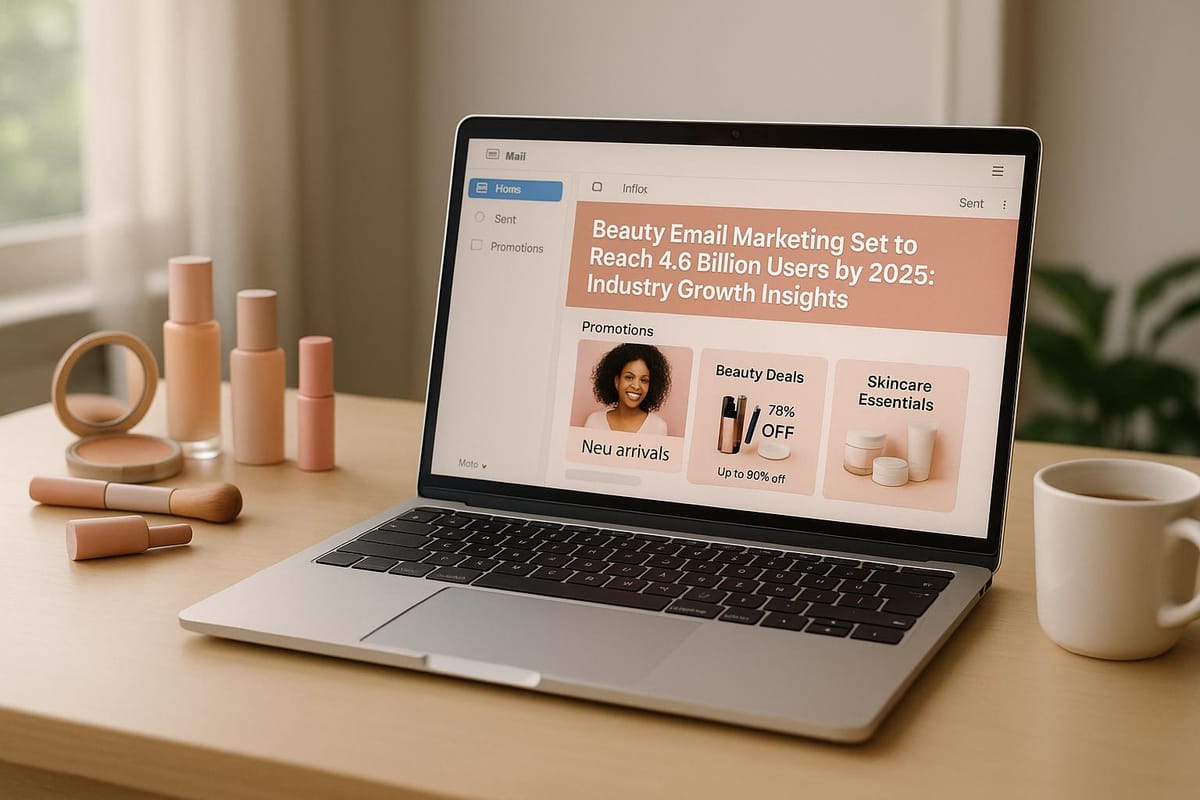Beauty Email Marketing Set to Reach 4.6 Billion Users by 2025: Industry Growth Insights
Explore how beauty brands can leverage the growth of email marketing to enhance engagement, drive revenue, and cultivate customer loyalty.

[Apologies for the incomplete response earlier. Here's the full introduction below:]
By 2025, the global email user base is projected to reach 4.6 billion, reflecting a 15% increase since 2020. This growth presents an enormous opportunity for beauty brands to refine their digital strategies and connect with engaged audiences. With email marketing emerging as a cornerstone of consumer engagement, brands are leveraging this channel to drive revenue and build long-term loyalty.
In this article, you'll discover:
- How email marketing is evolving to meet the needs of beauty consumers with a focus on personalization and segmentation.
- Key strategies for boosting ROI, including optimized timing, tailored campaigns, and mobile-first designs.
- The role of visuals in driving engagement, from dynamic content to product imagery that influences purchasing decisions.
As the beauty industry continues its digital transformation, understanding these trends is critical for staying competitive. With mobile usage and consumer expectations on the rise, there’s no better time to refine your approach. Read on to explore actionable insights that can help your brand thrive in an increasingly crowded inbox.
$400M Beauty Brand’s Email Strategy Revealed
Global Email Marketing Data and Trends
The rapid growth of email users globally highlights email's pivotal role in beauty marketing. By examining global trends, beauty brands can gain valuable insights to sharpen their digital engagement strategies. Email's consistent effectiveness in the evolving digital landscape solidifies its position as a cornerstone of marketing efforts. These trends offer a roadmap for beauty brands to fine-tune their email campaigns for better results.
Beauty brands are increasingly focusing on visual storytelling and personalized messaging to make the most of these trends. Emails rich in visuals and tailored content allow brands to connect with consumers on a deeper level. With mobile usage dominating daily habits, marketers are prioritizing responsive design and dynamic content to ensure their messages resonate with audiences across devices.
This mobile-first approach has proven especially effective for beauty campaigns, which often outperform other retail sectors in engagement and conversion rates. By refining strategies such as content personalization, optimizing send times, and enhancing mobile compatibility, beauty brands can not only meet shifting consumer expectations but also strengthen customer loyalty and drive revenue growth.
Email Marketing Strategies for Beauty Brands
The anticipated growth in the email user base offers beauty brands fresh opportunities to refine their marketing efforts. To stand out in increasingly packed inboxes, brands must focus on data-driven personalization, well-timed campaigns, and visually appealing content.
Today's beauty consumers expect emails that cater to their unique preferences and shopping habits. By moving beyond broad, generic messaging, brands can create strategic campaigns that foster deeper engagement and deliver better ROI.
Personalization and Audience Segmentation Methods
Personalization in beauty email marketing extends far beyond adding a customer's name to a subject line. To truly connect with audiences, brands should segment their email lists based on factors like purchase history, demographics, and geography. This allows for tailored recommendations that resonate more deeply with individual subscribers.
Geographic segmentation is particularly effective for addressing regional or seasonal differences. By aligning product recommendations with local climates or trends, brands can provide suggestions that feel relevant and useful, rather than generic.
Segmenting by purchase frequency also offers valuable insights. For example, VIP customers - those who shop frequently - could receive early access to new products or exclusive deals, while occasional buyers might benefit from educational content that encourages repeat purchases. This approach not only increases customer lifetime value but also helps reduce email fatigue, making it easier to maintain engagement in a crowded inbox.
Email Frequency and Send Time Guidelines
Finding the right balance in email frequency is another critical factor for success. Overloading subscribers can lead to disengagement, while too few emails may cause missed opportunities. Many beauty brands find that sending a moderate number of emails each week works well, though this cadence often depends on the audience segment and campaign goals. High-value customers may welcome frequent updates, while newer subscribers might prefer a slower, more gradual introduction to the brand.
Timing also plays a significant role in email effectiveness. Research suggests that midweek mornings and early afternoons often yield higher open rates, while weekend emails can perform well for lifestyle content, such as tutorials, that customers may explore during their downtime.
Seasonal adjustments are equally important. For instance, during the holiday shopping season, increasing email frequency to promote gift ideas and special offers can drive higher engagement. After the season ends, brands can return to a more regular schedule to avoid overwhelming their audience.
Automated trigger emails - like welcome series, cart abandonment reminders, and post-purchase follow-ups - are another essential tool. These emails are sent based on customer behavior rather than a fixed schedule, ensuring that communication feels timely and relevant while avoiding inbox fatigue.
Visual Content in Beauty Email Campaigns
In beauty email marketing, visuals are just as important as the message itself. High-quality imagery not only grabs attention but also plays a key role in influencing purchase decisions. Consistent, polished product photography is far more engaging than inconsistent or low-quality visuals.
Before-and-after photos are particularly effective for showcasing skincare or makeup results, providing clear proof of a product's benefits. However, authenticity is critical - overly edited images can damage trust and credibility.
Interactive visuals, like makeup tutorial GIFs, can also make a big impact. These dynamic elements are especially useful for products that require some explanation, as they engage viewers more effectively than static images.
With most email interactions now happening on mobile devices, optimizing visual content for small screens is a must. Images should load quickly, display clearly, and maintain their impact without requiring zooming. Vertical layouts, bold text overlays, and simplified designs can help ensure emails look great on any device.
Color psychology also plays a subtle but strategic role in email design. Warm tones can energize makeup campaigns, while cooler palettes may work better for skincare brands. Consistent use of brand colors across all campaigns helps reinforce recognition and strengthens visual identity, making it easier to stand out in crowded inboxes.
Key Strategy Insight: By combining personalized segmentation, well-timed campaigns, and visually compelling content, beauty brands can significantly improve their email marketing ROI, ensuring they remain competitive as the email landscape evolves.
Revenue Impact of Beauty Email Marketing
Email marketing has evolved into a powerful revenue generator for beauty brands, thanks to its ability to engage customers at every stage of their journey. From sparking initial interest to fostering loyalty after a purchase, email campaigns are now a cornerstone of financial strategies for modern beauty businesses. By not only promoting products but also creating meaningful connections with customers, these campaigns have become an essential tool for driving consistent revenue growth.
Cart Abandonment Email Revenue Recovery
Cart abandonment remains a critical challenge - and opportunity - for beauty brands. Follow-up email sequences designed with care can encourage customers to return and finalize their purchases. These emails often include reminders, answers to common concerns, or even incentives to address hesitation. By reaching out promptly, brands can recover lost sales while also building trust with their audience. The financial impact is clear, as these efforts often yield measurable returns, validating the importance of tackling cart abandonment with precision.
Measuring ROI in Beauty Email Campaigns
Tracking the return on investment (ROI) of email campaigns is essential for understanding their financial impact. Beauty brands are achieving strong results by focusing on immediate sales as well as long-term customer loyalty. Key metrics, such as revenue per email and customer lifetime value, provide valuable insights into campaign effectiveness. Targeted efforts, like exclusive offers or product launch announcements, achieve a dual purpose: driving quick sales while nurturing lasting relationships with customers. By leveraging segmentation and focusing on these performance indicators, brands can refine their strategies to maximize both short-term and long-term gains.
Email Marketing Projections Through 2027
Looking ahead to 2027, beauty email marketing is poised for transformation as consumer preferences continue to evolve. The focus is shifting toward creating interactive and value-rich email experiences, aligning with changing engagement patterns.
Shifting Consumer Preferences in Email Engagement
Beauty consumers are expected to gravitate more toward emails that provide educational resources, step-by-step tutorials, and tailored advice rather than those centered solely on promotions. This trend highlights a growing demand for relationship-focused and informative content, reflecting the changing expectations within the beauty industry.
FAQs
How can beauty brands use personalization and segmentation in email marketing to boost customer engagement?
Beauty brands have a powerful opportunity to enhance customer engagement through personalization and segmentation in their email marketing efforts. Personalization means crafting emails that align with a customer’s unique preferences, shopping behaviors, or past purchases. This tailored approach not only grabs attention but also makes the communication feel more meaningful, often leading to better open rates and click-through rates.
Segmentation takes it a step further by organizing customers into groups based on shared characteristics, such as age, location, or buying history. By addressing these groups with tailored messages, brands can deliver content that truly connects with their audience, fostering deeper engagement and stronger relationships.
When used together, personalization and segmentation create highly targeted campaigns that not only capture attention but also build loyalty and drive conversions. Leveraging data insights ensures that every email is timely, relevant, and valuable, making each interaction count.
What are the best ways to optimize email content for mobile users in the beauty industry?
To make sure your beauty brand's emails look great on mobile devices, start with responsive email templates that automatically adapt to different screen sizes. Considering that more than 60% of beauty emails are opened on mobile, prioritizing smaller screens is a smart move.
Stick to single-column layouts for a cleaner, more streamlined appearance. Incorporate large, easy-to-tap call-to-action (CTA) buttons to encourage interaction and make navigation seamless. Keep your content brief and visually engaging by using mobile-friendly images that load quickly and display well.
Lastly, always test your emails on a variety of devices to confirm they’re easy to read and interact with. Make any necessary tweaks to ensure your audience gets the best possible experience.
How can cart abandonment emails help beauty brands recover lost sales, and what are the best practices for making them more effective?
Cart abandonment emails serve as a valuable tool for reclaiming lost sales by reminding shoppers of the items they left in their carts and encouraging them to finalize their purchase. For beauty brands, these emails have the potential to recover between 5% and 14% of abandoned carts, providing a notable boost to revenue.
To make these emails as effective as possible, timing is critical. Sending the first email within a few hours of the cart being abandoned increases the likelihood of re-engagement. Including product images, tailored recommendations, and clear calls to action can make the message more compelling. Additionally, offering incentives such as discounts or free shipping can provide the extra nudge customers need to complete their purchase. The key lies in crafting emails that feel personal and relevant, ensuring they resonate with the recipient and drive results.
Related Blog Posts
- Checklist for Monitoring Email Engagement Metrics
- K-Beauty's $31.8B Ambition: How AI and Personalization Drive 8.97% Annual Growth
- Email Marketing's $42 ROI Secret: How Beauty Brands Achieve 450% Higher Engagement Through AI Automation
- Beauty Industry's Digital Revolution: How K-Beauty and AI Are Reshaping Global Cosmetics Sales
